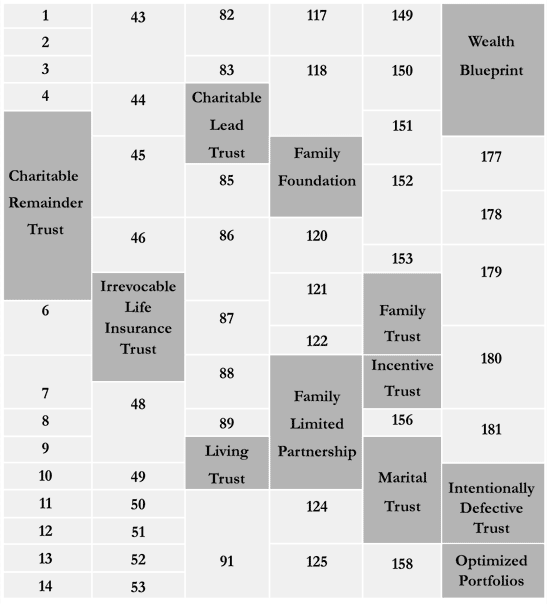| 51 | Distribute employer securities from 401(k) tax-free |
| 52 | Manage family business succession |
| 53 | Cancel debt obligations at death |
| 54 | Carry-back operating losses to earlier years |
| 55 | Maximize control over social capital |
| 56 | Examine tax-efficient business merger options |
| 57 | Motivate key employees |
| 58 | Equip future family business leaders |
| 59 | Minimize IRD taxes |
| 60 | Control long-term care expenses |
| 61 | Sell an unneeded life insurance policy |
| 62 | Fund long-term care costs |
| 63 | Re-organize a family business |
| 64 | Monetize illiquid assets |
| 65 | Circument Rule Against Perpetuities |
| 66 | Provide stewardship training |
| 67 | Create amendable irrevocable trusts |
| 68 | Pursue aggressive tax planning |
| 69 | Increase inheritance for heirs |
| 70 | Fund a buy-sell agreement |
| 71 | Manage business in tax-free environment |
| 72 | Reduce estate expenses and delays |
| 73 | Optimize an annuitiy arbitrage |
| 74 | Evaluate complexity threshold |
| 75 | Evaluate Tenant in Common funds |
| 76 | Evaluate risk tolerance |
| 77 | Provide incentives for heirs |
| 78 | Terminate a split dollar agreement |
| 79 | Make tax-efficient transfers to heirs |
| 80 | Facilitate a 1035 exchange |
| 81 | Avoid taxes on deferred compensation |
| 82 | Plan for a non-citizen spouse |
| 83 | Facilitate multi-state probate |
| 84 | Evaluate performance attribution |
| 85 | Facilitate a 1031 exchange |
| 86 | Avoid unnecessary IRA payments |
| 87 | Develop a pre-nuptial plan |
| 88 | Accelerate inheritances to children tax-free |
| 89 | Fund college educations tax-efficiently |
| 90 | Compare 6166 installment sales to alternatives |
| 91 | Transfer IRA assets to heirs |
| 92 | Create a post-nuptial agreement |
| 93 | Sell business tax-free |
| 94 | Maximize non-qualified plan deductions |
| 95 | Enhance retirement plan returns |
| 96 | Mediate conflicts regarding wealth |
| 97 | Convert ordinary income into capital gains income |
| 98 | Step-up the basis of assets before sale |
| 99 | Avoid taxes on trust income |
| 100 | Maintain liquidity for emergencies |


